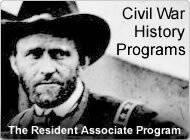
Book Review - A Clearing in the Distance--Frederick Law Olmsted and America in the Nineteenth Century, by Witold Rybczynski
The Smithsonian Associates Civil War E-Mail Newsletter, Volume 2, Number 2
Civil War era biographies too often are written as if their Civil War subjects exist only because of the Civil War. So much so, that it is hard to imagine that individuals such as U. S. Grant, J. L. Chamberlain, or Elisha Hunt Rhodes would have existed if there had been no Civil War.
This Civil War biography is unlike others, because the war did not define who Frederick Law Olmsted was or how he lived the remainder of his life. Olmsted's life was significant apart from it, as well as before and after it.
Olmsted was born to a relatively wealthy merchant family in New England. As a result, he was well educated but rather aimless about his future. Through the author we come to understand how this man with so many diverse interests--travel, writing, farming, science, the outdoors, and art--combined them all to become both a social historian and one of the first landscape architects in this country.
Olmsted's journalism career began with the New York Times. In the 1850s he traveled throughout the South providing a series of articles which eventually became the classic study, The Cotton Kingdom. Olmsted's work gave Northern readers the first dispassionate study of the antebellum South. He does not condemn slavery outright, but logically concludes, what is obvious today but was not obvious in the 19th century, that the economy of the South was impractical and that slavery degrades and demoralizes all who participate in it. In this work we see the first glimpse of Olmsted's true interest, how modern society ("civilization," as the term was used then) should live in a democracy.
During the war Olmsted served as head of the United States Sanitary Commission, which provided medical supplies, care, and comfort to the soldiers at the front. He was an expert organizer, and initiated innovative systems to track and account for materials and the soldiers that the Commission served. These skills were essential in his later career.
After the war, with his resourcefulness and his understanding of organization and basic human nature, Olmsted began his career as a landscape architect in earnest. After promoting the concept of Central Park in New York, he planned, oversaw, and maintained the Park for many years. He was soon called upon to create Prospect Park in Brooklyn, Back Bay in Boston, the Capitol Grounds in Washington D.C., the World's Columbian Exposition in Chicago, as well as the design of private projects including Stanford University and the Biltmore Estate in Asheville, North Carolina. Olmsted also championed what became the National Park Service.
In the early 1860s, he visited Yosemite and sought to have it established as a national park to be preserved for the use and enjoyment of all Americans. He was also instrumental in protecting Niagara Falls by creating a scenic reservation around the site.
The nature of landscaping does not allow for a project ever to be "complete." Olmsted had the vision to plan the evolution of his projects to be borne out in future decades. However, there is a more tangible project that Olmsted did not complete. It was to be "a heavy-sort of book on society in the United States," a book about "the influence of pioneer-life and of democracy." It was to be a book about American society. He hoped to discuss how the Western frontier, immigration, and the creation of large cities and suburbs, would not result in mediocrity, but instead would create an individualism resulting in universal prosperity. He believed that such prosperity was the result of living in a democracy. This democracy, initiated by the American Revolution and reaffirmed by the American Civil War, is manifested in the public parks and open landscapes he created. Frederick Law Olmsted's legacy is all around us, and like a democratic society, it continues to evolve and it will never be complete.

